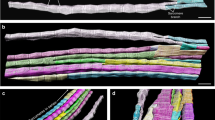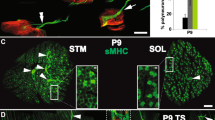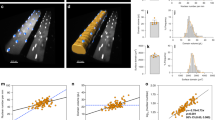Abstract
IF adult skeletal muscles are denervated the difference in twitch speed between slow and fast muscle persists1,2. This suggests that either there are inherent differences between the two types of muscle or that, once differentiated, they can only alter their contractile properties if another pattern of activity is imposed on them by cross-union of slow and fast motor nerves3 or by stimulation4. The finding that there is a difference in contractile properties already at birth5 suggests that slow and fast muscles have inherent differences. These experiments were performed to see whether slow and fast muscles can differentiate from birth in the absence of innervation.
This is a preview of subscription content, access via your institution
Access options
Subscribe to this journal
Receive 51 print issues and online access
$199.00 per year
only $3.90 per issue
Buy this article
- Purchase on Springer Link
- Instant access to full article PDF
Prices may be subject to local taxes which are calculated during checkout
Similar content being viewed by others
References
Lewis, D. M., J. Physiol., 161, 24P (1961).
Syrovy, I., Gutmann, E., and Melichna, J., Experientia, 27, 1426 (1971).
Buller, A. J., Eccles, J. C., and Eccles, R. M., J. Physiol., 150, 417 (1960).
Salmons, S., and Vrbová, G., J. Physiol., 201, 535 (1969).
Close, R., J. Physiol., 173, 74 (1964).
Blunt, R. J., and Jones, R., J. Physiol., 226, 99 (1972).
Shafiq, S. A., Asiedu, S. A., and Milhorat, A. T., Exp. Neurol., 35, 529 (1972).
Tower, S. S., Physiol. Rev., 19, 1 (1939).
Vrbová, G., Quart. J. Exp. Physiol., 52, 411 (1967).
Fischbach, G. D., and Robbins, N., Physiologist, 10, 170 (1967).
Eccles, J. C., Med. J. Aust., 2, 1960 (1941).
Pette, D., Smith, M. E., Staudte, H. W., and Vrbová, G., Pflügers Arch., 338, 257 (1973).
Author information
Authors and Affiliations
Rights and permissions
About this article
Cite this article
BROWN, M. Role of Activity in the Differentiation of Slow and Fast Muscles. Nature 244, 178–179 (1973). https://doi.org/10.1038/244178a0
Received:
Issue Date:
DOI: https://doi.org/10.1038/244178a0
This article is cited by
-
Differentiation of fast and slow muscles in the rat after neonatal denervation: A physiological study
Journal of Muscle Research and Cell Motility (1988)
-
Effect of neonatal denervation on the distribution of fiber types in a mouse fast-twitch skeletal muscle
Histochemistry (1988)
-
Denervation of newborn rat muscles does not block the appearance of adult fast myosin heavy chain
Nature (1982)
-
The role of muscle development in the transition to endothermy in nestling bank swallows,Riparia riparia
Journal of Comparative Physiology ? B (1982)
-
The influence of electrical activity on the development of newborn innervated rat muscles
Pflügers Archiv - European Journal of Physiology (1981)
Comments
By submitting a comment you agree to abide by our Terms and Community Guidelines. If you find something abusive or that does not comply with our terms or guidelines please flag it as inappropriate.



